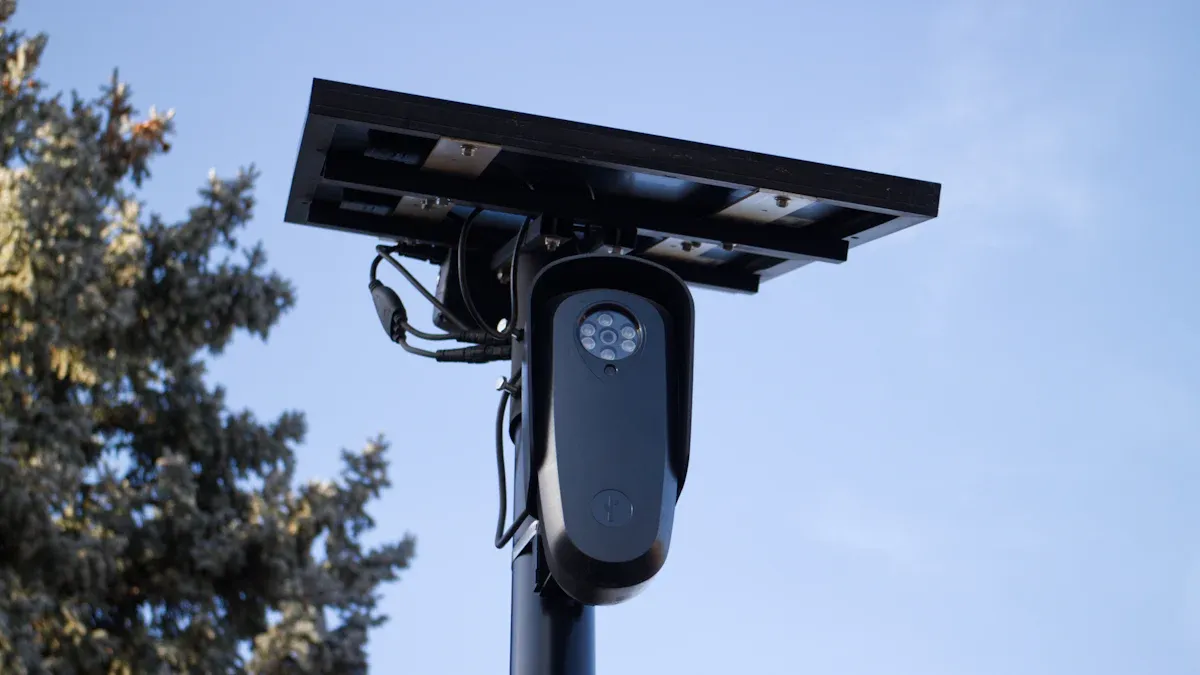Why AI Powered Technology Transforms Retail Loss Prevention

You see a new time in retail loss prevention as ai powered technology helps. Old security ways often miss small threats. Today, rising shrinkage costs stores billions each year.
The average shrink rate was 1.6% in 2022, costing $112.1 billion.
In 2023, retail shrinkage was about 1.4% of sales, with almost $100 billion lost.
In 2024, fake returns alone caused $103 billion in losses.
You need smart solutions that change fast. Ai powered systems can find risks quicker and help keep your business safe.
Key Takeaways
AI technology helps stores spot theft as it happens. This lets workers act fast if someone tries to steal.
Using AI-powered video analytics can lower shrinkage a lot. It finds people acting suspicious and tells security right away.
RFID and smart shelves make it easier to track items. They help stop theft and keep shelves full.
AI systems can lower false alarms by up to 90%. This lets security focus on real problems and work better.
Teaching staff how to use new AI tools is very important. It helps them stop theft and keeps shopping safe for everyone.
Retail Loss Challenges

Shoplifting Trends
Shoplifting is a bigger problem for stores now. Every year, stores lose more money from shrink. In 2022, shrink was 1.6% of sales. That was higher than 1.4% in 2021. Stores lost about $112.1 billion in 2022. This was more than the $93.9 billion lost in 2021. Almost two-thirds of shrink comes from theft. Organized retail crime now causes 36% of all losses.
Stores around the world may lose $132 billion to shrink in 2024. This is more than the $112 billion lost in 2022.
Shoplifting makes it hard for stores to make money.
Shoplifting is getting harder to stop. Groups of people work together to steal from stores. Self-checkout lanes give shoplifters new ways to steal. People keep finding new ways to hide stolen things. There are more fights with shoplifters now. These fights went up by 40% last year.
Evidence Description | Statistic |
|---|---|
More fights with shoplifters | 40% increase |
30% of cases | |
Hiding items in clothes or bags | 60% of cases |
Stores making less money | 12% drop each year |
Money spent to stop loss | $700 million |
Shoplifting happens more in big cities. In the first half of 2023, police in big cities like New York City got 16% more reports than in 2019.
Internal Theft Issues
Stores also have to worry about theft from workers. Internal theft is a big part of shrink. It is about 29% to 33% of all shrink. This means workers can steal almost as much as outside thieves.
Type of Theft | Percentage of Retail Loss |
|---|---|
Internal Theft | 29% |
External Theft | 36% |
Workers use many tricks to steal. Some hide things in trash or on themselves. Some do gift card fraud or sweethearting. Sweethearting is when workers give friends free stuff or discounts. Some workers steal customer information. Others take small amounts of cash over time.
Method of Internal Theft | Description |
|---|---|
Stealing products | Workers hide items in trash or on themselves to steal. |
Gift card theft | Workers give fake refunds to gift cards or swap loaded cards. |
Sweethearting | Cashiers do not ring up goods for friends or give discounts. |
Identity theft | Workers steal customer information, like credit card numbers. |
Skimming | Workers take small amounts from the cash drawer over time. |
Stores need better ways to stop shoplifting and worker theft. Ai powered technology helps find risks and keeps stores safe.
AI Powered Technologies

Stores today face many problems, but new tools can help. AI powered technologies help you find risks and watch your store. These systems work right away and send alerts fast. You can use different types of technology to keep your store safe.
Video Analytics
Video analytics let you watch your store all the time. AI powered video analytics check live cameras and spot odd actions fast. These systems do more than just record. They can:
Find people standing near expensive things for too long.
See if someone hides items in bags or clothes.
Notice if someone visits often but never buys.
Send alerts to your security team right away.
These features help you stop theft before it happens. Video analytics also help you see patterns in how people act. This makes it easier to find problems and fix your store’s setup. Many stores use these systems to send alerts and do tasks automatically. About 78% of stores use AI to spot important events and help in emergencies.
Metric | Improvement |
|---|---|
Supply Chain Errors | |
Warehousing Costs | Lowered by up to 40% |
Lost Sales Opportunities | Dropped by about 65% |
Order Fulfillment Time | Got better by over 14% |
These numbers show video analytics save money and help you work better.
Tip: AI powered video analytics can link with alarms and other security systems. This gives you a full view of your store’s safety.
Behavior Recognition
Behavior recognition uses smart cameras and software to watch for odd actions. You can use this to spot shoplifters or people trying to cheat. The system looks for:
People staying in one spot too long without buying.
Shoppers putting things in bags or backpacks.
People hiding items or moving in strange ways.
The same person coming back many times.
When the system sees something odd, it sends an alert to staff. This helps you act fast and stop theft. Some stores use facial recognition to spot known shoplifters as soon as they walk in. For example, Target uses this to warn security when a flagged person enters. In Europe, stores use facial recognition only for suspected thieves to protect privacy.
Behavior recognition is better than old security. It can see things people might miss and helps you act quickly.
RFID and Smart Shelves
RFID and smart shelves help you track every item in your store. RFID tags let you know where products are, even if you can’t see them. Smart shelves use weight sensors and cameras to check if items are missing or moved.
Here’s how these tools help you:
RFID tracks where items go and helps find missing things.
Smart shelves send alerts if someone takes items without paying.
RFID checks if returned items match what was sold, stopping fake returns.
These systems help you build strong cases against organized retail crime.
Most stores now use or plan to use RFID. About 76% of store leaders say they use it, and almost 40% want to add AI cameras and facial recognition. RFID and smart shelves can cut shrinkage in risky areas by over 40%. For every dollar spent on RFID, you can save up to four dollars.
Statistic | Description |
|---|---|
$100B/year | Global retail shrinkage costs |
>40% | Shrinkage drop in risky areas with RFID/IoT tracking |
$1:$4 | Savings for every dollar spent on RFID |
10-20% | More theft stopped by better visibility |
Note: RFID and smart shelves also help keep shelves full, so you don’t lose sales from empty spots.
AI powered technologies help you stop theft before it happens. You can use real-time alerts, person tracking, item recognition, and crowd watching to keep your store safe and running well.
Benefits for Retailers
Real-Time Alerts
You can act faster with real-time alerts. AI powered systems watch your store all the time. They send you a message right away if something odd happens. This lets you stop theft before it starts. Security teams can go to the right spot quickly. You do not have to wait for someone to check the cameras. You get alerts fast, so your store stays safer.
Evidence Description | Impact on Response Times and Theft Reduction |
|---|---|
Real-time synchronization sends alerts to many security channels at once. | This helps security teams work together fast with AI analytics. |
AI surveillance cameras and software check data right away. | This helps find theft faster and lets teams act quickly. |
Custom alerts tell security staff right away. | This helps them respond fast to possible theft. |
90% accuracy rate in spotting possible theft with real-time checks. | This helps security teams stop losses before they happen. |
You can use these alerts to teach your staff. When workers know what to do, they can help stop theft even faster.
Fewer False Positives
Old security systems often send too many false alarms. This wastes time and energy. AI powered tools can cut false alarms by half. You spend less time on things that are not real threats. Security teams do not get too many alerts that do not matter. This means you can trust the system to show real problems.
AI systems can cut false alarms by up to 90%.
Fewer false alarms help your team stay sharp and ready.
Operational Efficiency
AI helps you run your store better. It can guess how much you will sell, so you buy the right amount. You do not run out or have too much left over. AI also finds slow spots in your supply chain and gives better ways to ship. This saves money and makes deliveries faster.
AI helps find fraud by spotting odd patterns.
It helps you plan how many workers you need.
You can put security teams where they are needed most, based on busy times and places.
Tip: AI analytics help you find risky spots and busy times, so you can use your team wisely.
You get a safer store and smoother work when you use these smart tools.
Implementation & Future Trends
Integration Steps
You can add new security technology to your store by taking simple steps. Here is an easy way to begin:
Assess Current Security Infrastructure
Check your cameras and sensors. See what works well and what does not. Make sure your system can use new technology.Choose the Right AI Theft Detection Solution
Pick a system that finds theft well. Make sure it fits with your current tools. Choose one your team can use easily and that can grow with your store.Data Integration and System Compatibility
Connect your new system to your cash registers, inventory, and cameras. Use safe ways to protect your data. Decide if you want your system in the cloud or in your store.Train Staff and Manage Change
Teach your team how to use the new tools. Tell them why the change is good. Watch how the system works and fix problems fast.
Tip: Training your staff well helps you get the most from your new security tools.
Privacy & Compliance
You must follow privacy laws when you use new security systems. Here are some rules and how stores follow them:
Regulation | Scope | Key Requirements |
|---|---|---|
FERPA | Schools | Protects student records, needs consent for sharing video |
HIPAA | Healthcare | Keeps health data safe, controls who can see it |
COPPA | Kids' stores | Needs parent consent for collecting data from children under 13 |
Section 1983 | Government | Stops rights violations by public workers |
California Consumer Privacy Act (CCPA): Tells people what data you collect.
Illinois Biometric Information Privacy Act (BIPA): Needs permission for face or fingerprint data.
Colorado AI Act: Needs checks for high-risk AI systems.
Stores use smart tools to keep data safe. These tools mark private data, watch for problems, and keep records for audits. AI can also hide personal details and help you get permission from customers.
Future Outlook
Store security will change a lot soon. More stores will use ai powered systems to spot theft and fraud right away. Many workers worry about safety, and half of all stores plan to use AI for loss prevention in the next few years.
"When you can bring these solutions together in one package for a retailer, then you're really gaining significant ground on intelligence, on evidence gathering, on law enforcement partnerships because it takes a village." – Mike Lamb, former VP of Asset Protection at Kroger, Walmart, and The Home Depot
AI will help you report crimes faster and keep your team safe. New tools like voice event reporting and AI-suggested investigations will become normal. In the next ten years, robots and drones may help watch stores. AI will help you stop problems before they start, making your store safer and work better.
You can now make your store much safer. AI powered solutions help you stop problems before they happen. You do not have to wait for theft to occur. Stores have lost more than $121 billion from theft. But you can help lower this number. Experts say these systems make stores safer and help you work better. They also help you make smart choices.
Benefit | Description |
|---|---|
Enhanced Safety | Makes staff and customers feel safer |
Better Decision Making | Gives you quick facts so you can act fast |
Future-Proofing | Gets your store ready for new risks and chances |
Start using smarter loss prevention now. Your store’s future needs it.
FAQ
How does AI help stop shoplifting in real time?
AI watches your store through cameras and sensors. It spots odd actions, like hiding items or staying too long in one spot. You get alerts right away, so you can act fast and stop theft.
Is AI technology hard to add to my store?
You can add AI tools to most modern systems. Many solutions work with your current cameras and software. Training your team helps you get the best results.
Will AI-powered systems protect customer privacy?
Yes. You control what data the system collects. Many AI tools hide faces or personal details. You must follow privacy laws and get consent when needed.
What are the main benefits of using AI for loss prevention?
You get faster alerts, fewer false alarms, and better store safety. AI helps you save money and keep your shelves full. Your team can focus on real threats, not false ones.
See Also
The Future of Retail: Embracing AI-Driven Stores
Modern Retail's Edge: Benefits of AI-Enhanced Vending Machines
Transforming Online Retail Management with AI Tools
Essential Insights for Retailers on AI-Driven Corner Stores
Revolutionizing Retail: Smart Technology in Electronics Vending Machines
